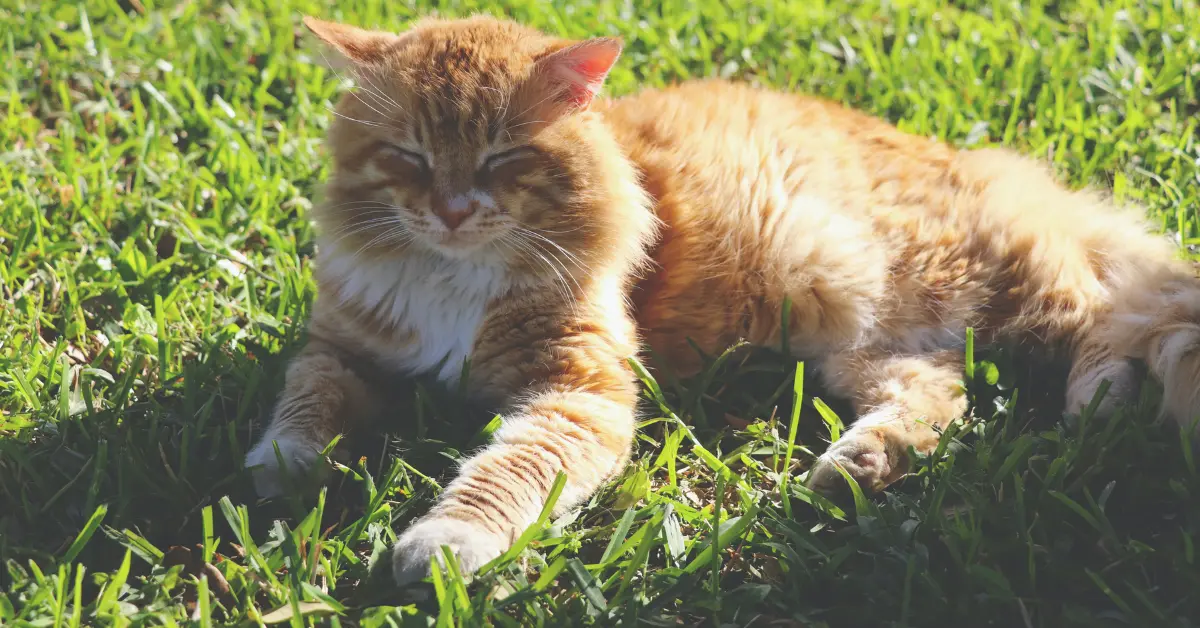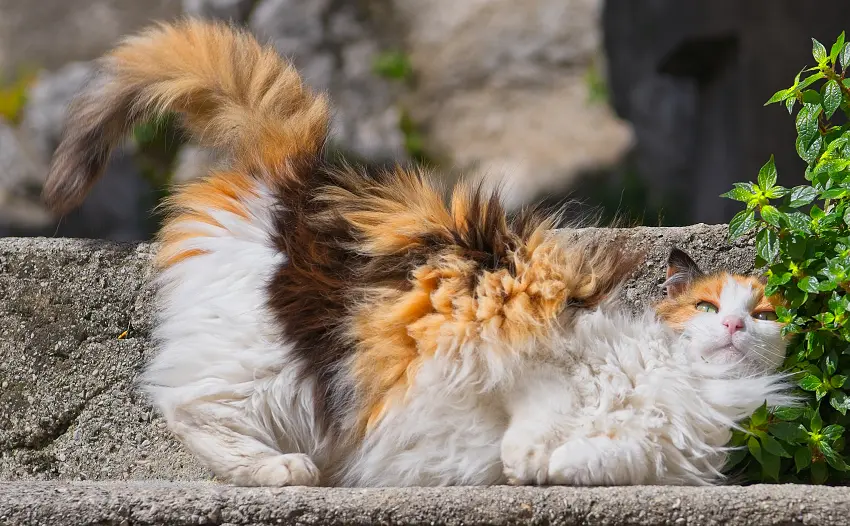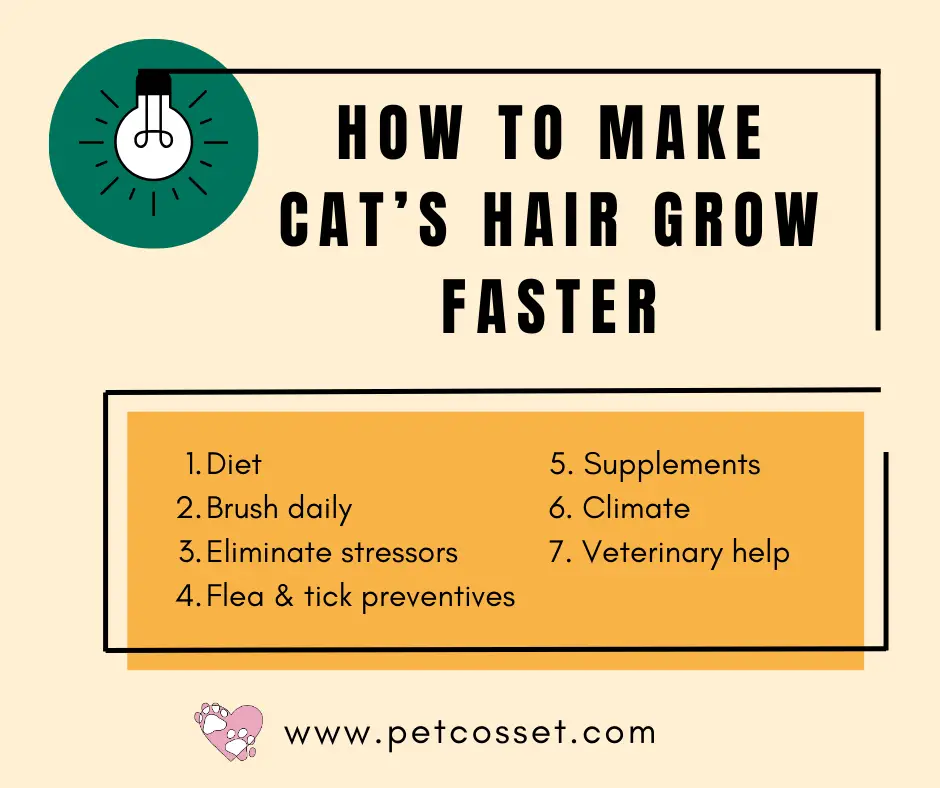How Fast Does Cat Hair Grow? 7 Ways To Speed Up The Process
If your cat has been shaved for surgery or grooming, you’re probably asking, how fast does cat hair grow back? It depends on several factors! This includes your cat’s coat type, its health condition, its diet, and how the hair was shaved.
In this post, I discuss this topic to help fellow cat owners speed up their kitty’s hair growth. I also added a few tips, which worked in regaining the hair of our cat Watson.

How long does it take for cat hair to grow?

On average, a cat’s hair will grow back within 3 to 6 months after it’s been shaved or cut off. However, long-haired types may take longer than that to regain their normal coat.
Take note that cats are like humans; they have varying hair growth speeds. Others grow their fur within weeks while some may take months.
Nevertheless, there are ways to help your kitty grow its hair faster and healthier. Below, we discuss these tips together with other information to help you out.
Reasons why your cat’s hair needs to be shaved

While it’s not advisable to shave cats, some situations call for it. It’s usually because of grooming or a veterinary procedure.
- Grooming. Long-haired cats are prone to matting, so there might be a need to shave areas of their coat. A professional groomer can do this for you to prevent damaging the skin of your pet.
- Surgery. The surgical area of your cat’s body will be shaved to remove the hair in the way. This way, stray hairs won’t cause infection or interfere with the procedure.
However, it’s also important to know that cats can lose hair even without intentional shaving. Here are the usual culprits why your cat’s hair is not growing back:
- Hormonal imbalance. Hormonal imbalances can kill the hair follicles of your cat. When this happens, the hair strand will no longer grow back despite all your efforts.
- Infections. Parasitic, bacterial, and fungal infections will hinder the healthy growth of your cat’s hair. Proper treatment is necessary to prevent permanent damage to your cat’s coat.
- Excessive grooming. Cats suffering from compulsive behavior may groom themselves excessively. The continuous licking and chewing will cause bald spots that may or may not grow back.
How to make your cat’s hair grow faster
To ensure that your cat’s hair will grow back fast and healthy, you can try the following tips:

1. Switch to a coat-friendly diet
The best way to ensure fast and healthy growth of your cat’s hair is by giving it a suitable diet.
Consider a diet rich in Omega fatty acids as well as DHA and EPA. These nutrients boost coat health, which will eventually speed up the production of new hair.
Aside from that, a high-protein diet will also help. However, make sure that it’s suitable for your cat as too much protein can cause kidney issues in felines.
If you plan to switch your cat to a new food, make sure that you do so gradually. Start by replacing a small portion of its current diet with the new food and increase it over the weeks.
2. Brush regularly
Regular brushing of your cat’s coat will also help increase its hair growth. Through brushing, you can trigger the production of natural sebum, which is crucial for coat health.
Aside from that, regular brushing will help remove dirt from your cat’s hair. This way, it won’t block follicles or cause irritations that impact hair growth.
In general, brushing your feline three to four times a week would be enough. Meanwhile, long-haired breeds need to be brushed daily to avoid matting.
3. Eliminate stressors
Chronic stress can cause cats to scratch and lick their bodies excessively. This will lead to further hair loss or very slow growth.
This is why you should remove or limit potential stressors in your home. By keeping your household calm, your cat can rest and you can reduce the risk of compulsive behavior.
Overall, avoid playing loud sounds, exposing the kitty to strangers, or introducing a new pet. Try to avoid sudden changes as well, which can stress your pet.
4. Use flea and tick preventives
Ticks and fleas will sabotage your cat’s hair growth. This is why you should be proactive with the use of preventives.
You can choose from topical or oral preventives to repel insect pests from getting into your cat’s coat. But before you pick any of these options, make sure that you talk to your cat’s veterinarian first.
While flea preventives are helpful, they can be dangerous if used with the wrong dosage and type.
5. Consider supplements
Usually, a complete and balanced diet would be enough to support hair growth in cats. But if you want, you can ask the vet about giving your feline a hair-boosting supplement.
Fish oil supplements are the safest and most effective when it comes to growing cat hair. It’s rich in Omega fatty acids, which prevent inflammation while enhancing the feline’s coat.
6. Control the room temperature
A cat’s shedding cycle depends on the temperature of its surroundings. If it gets hotter than 102F, the kitty’s fur will start to shed to help cool its body.
To ensure that your pet won’t lose more hair in the process, you must keep your home cool. This way, your cat’s body won’t trigger its shedding cycle.
7. Seek veterinary help
Lastly, you should consider consulting your pet’s veterinarian about the best hair-growing solution to use. This is the best decision if your feline’s hair is shedding continuously or not growing back for months already.
At the vet’s clinic, your cat will undergo tests and examinations. This is to determine whether it’s suffering from underlying health problems, which cause hair loss.
Does cat hair grow back if cut?
A cat’s hair will grow back normally after it’s cut or shaved. A healthy kitty will regain its normal coat within 3 to 6 months.
However, if your pet’s hair isn’t growing back, it’s best to consult a veterinarian. There might be another problem that’s slowing down proper hair growth.
Is it a good idea to shave cats in the summer?
A cat’s coat is designed to shed normally during summer. This way, the feline can regulate its body temperature without any human intervention.
With this, shaving your cat’s fur during summer has no apparent benefits. In fact, it could do more harm if you shave it too close to the feline’s skin.
Unless your cat has matting, grooming issues, or a scheduled veterinary treatment, there’s no reason to shave its fur.
In the end, you should just let your kitty do its own temperature regulation. After all, their wild cousins can survive intense heat without being shaved by humans.
Does cat’s fur grow longer as they age?
Unlike humans, a cat’s fur won’t grow infinitely long. At some point, the kitty will reach its coat’s terminal length or the maximum hair length that its genetics dictate.
Once the maximum length is reached, the cat’s hair will fall off and the growth cycle restarts.
With that, there’s no truth to the myth that a cat’s fur will become longer as it becomes older. The only change that will occur is color fading, which is associated with old age.
Should I give my cat a lion cut?
A lion cut should only be done on cats with matting problems. It’s usually an option for flat-nosed breeds since they can’t groom their bodies properly.
A professional groomer is the best person to perform a lion cat to your pet. This is to prevent skin problems due to close shaving.
Aside from that, the groomer can advise about how often the cut needs to be done to maintain your pet’s cleanliness.
How do I fix my cat’s bald spot?
To fix a bald spot on your cat’s coat, you first have to address the reason behind it. Bald patches due to alopecia, skin infections, compulsive behavior, and so on are best handled by a veterinarian.
Once the condition is treated, you can perform regular coat care and grooming to stimulate hair growth on the bald spot. Depending on the severity of the condition, it may take months to years for a cat’s bald spot to fully resolve.
Conclusion
How fast does cat hair grow? On average, it will take up to six months for felines to grow their lost hair back.
However, this speed is affected by several factors, including proper care, diet, and health conditions. In the end, the vet is always the best person to consult if your pet’s hair isn’t growing back as expected.
